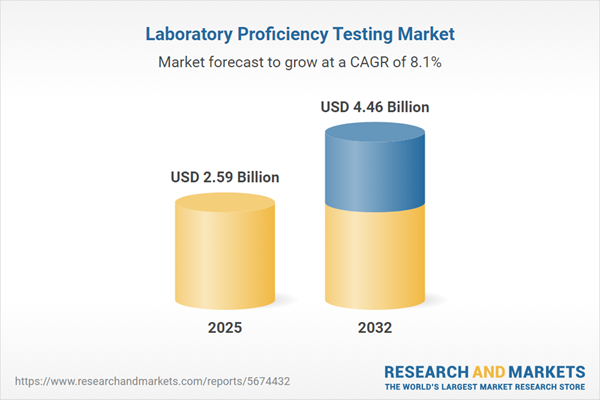Speak directly to the analyst to clarify any post sales queries you may have.
Laboratory proficiency testing plays a strategic role in advancing global quality assurance and regulatory compliance. Senior decision-makers increasingly rely on robust proficiency testing solutions to validate analytical accuracy, optimize operational reliability, and maintain competitive positioning in complex scientific markets.
Market Snapshot: Laboratory Proficiency Testing Market
The laboratory proficiency testing market grew from USD 2.39 billion in 2024 to USD 2.59 billion in 2025 and is projected to reach USD 4.46 billion by 2032 at a CAGR of 8.08%. Steady growth reflects rising international standards, expanding regulatory scrutiny, and rapid technological advancements affecting laboratories worldwide.
Scope & Segmentation Overview
- Category: Biological analysis (including enzyme, immunoassay, and molecular analysis), chemical analysis (inorganic and organic testing), and microbiology analysis (bacteria, fungi, viruses).
- Application: Environmental (air, soil, water), food and beverages (including bakery, beverages, dairy products, meat and poultry), healthcare and diagnostics (clinical chemistry, hematology, immunology, microbiology), pharmaceutical (drug development, GMP compliance, quality control), and tobacco (nicotine content analysis, quality control testing).
- End User: Diagnostic laboratories (hospital, independent, specialty labs), environmental testing labs (private, public sector), food and beverage manufacturers (beverage, confectionery, dairy, meat processors), government agencies (environmental, food safety, health departments), pharmaceutical companies (biotech firms, generic, large pharma).
- Distribution Channel: Direct sales (authorized representatives, original manufacturers), distributors (tier one, tier two), and online sales (company websites, third-party platforms).
- Geography: Americas (United States, Canada, Latin America), Europe, Middle East & Africa (Western and Eastern Europe, Middle East, Africa), and Asia-Pacific (China, India, Japan, Australia, Southeast Asia).
- Technology Focus: Integration of artificial intelligence, machine learning, digital connectivity, automation, and cloud-based reporting for accelerated analytics.
- Key Companies Covered: SGS SA, Bureau Veritas S.A., Intertek Group plc, Eurofins Scientific SE, LGC Limited, Thermo Fisher Scientific Inc., Bio-Rad Laboratories, Inc., R-Biopharm AG, Neogen Corporation, Randox Laboratories Ltd.
Key Takeaways for Decision-Makers
- Proficiency testing is shifting from a compliance-centric approach to a strategic quality improvement tool, enhancing laboratory reputation and operational resilience.
- Advances in automation, digitalization, and predictive analytics empower laboratories to streamline reporting, benchmark performance, and support continuous improvement.
- Technical harmonization across jurisdictions facilitates international recognition of test results and simplifies cross-border collaboration among laboratories.
- Hybrid distribution models, including direct, distributor, and online sales, now enable flexible, rapid access for laboratories of varying size and specialization.
- Consultative support—such as training, corrective action planning, and regulatory guidance—drives deeper client engagement and strengthens service provider differentiation.
- Strategic regional partnerships and platform investments are enabling providers to better address capacity limitations and emerging market demands.
Tariff Impact and Supply Chain Considerations
Revised 2025 United States tariff structures have increased the cost base for proficiency testing providers, driving a reassessment of sourcing, supplier agreements, and logistics. Service providers are optimizing operations by regionalizing supply chains, collaborating with domestic partners, and adjusting program offerings. Laboratories are responding by refining testing calendars and stockpiling essential consumables to mitigate disruptions. Agility in design and early, transparent stakeholder communications have become imperative in navigating evolving trade environments.
Methodology & Data Sources
This report integrates primary research—structured interviews with laboratory directors, quality managers, and regulatory representatives—with secondary research such as technical literature, guidelines, and industry white papers. Insights are validated using statistical segmentation, thematic analysis, and expert panel review to ensure high reliability and relevance.
Why This Report Matters
- Enables leaders to design adaptive, future-ready proficiency testing programs that go beyond compliance, driving operational excellence.
- Delivers granular, actionable segmentation and regional insights, supporting targeted market entry and expansion strategies.
- Highlights technology, distribution, and regulatory trends directly shaping the evolution of laboratory proficiency testing and supply networks.
Conclusion
The laboratory proficiency testing market is entering a dynamic era, shaped by technological and regulatory change. Stakeholders leveraging these insights will strengthen their strategic positioning and raise quality standards across global laboratory networks.
Additional Product Information:
- Purchase of this report includes 1 year online access with quarterly updates.
- This report can be updated on request. Please contact our Customer Experience team using the Ask a Question widget on our website.
Table of Contents
3. Executive Summary
4. Market Overview
7. Cumulative Impact of Artificial Intelligence 2025
List of Figures
Samples

LOADING...
Companies Mentioned
The key companies profiled in this Laboratory Proficiency Testing market report include:- SGS SA
- Bureau Veritas S.A.
- Intertek Group plc
- Eurofins Scientific SE
- LGC Limited
- Thermo Fisher Scientific Inc.
- Bio-Rad Laboratories, Inc.
- R-Biopharm AG
- Neogen Corporation
- Randox Laboratories Ltd
Table Information
| Report Attribute | Details |
|---|---|
| No. of Pages | 198 |
| Published | October 2025 |
| Forecast Period | 2025 - 2032 |
| Estimated Market Value ( USD | $ 2.59 Billion |
| Forecasted Market Value ( USD | $ 4.46 Billion |
| Compound Annual Growth Rate | 8.0% |
| Regions Covered | Global |
| No. of Companies Mentioned | 11 |









